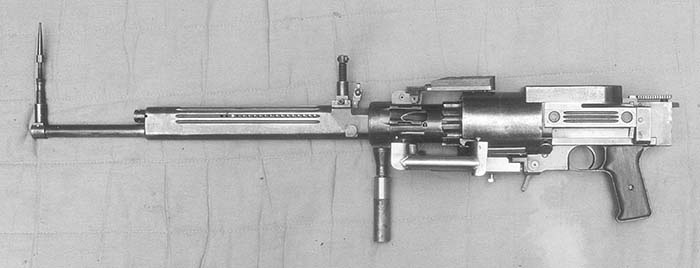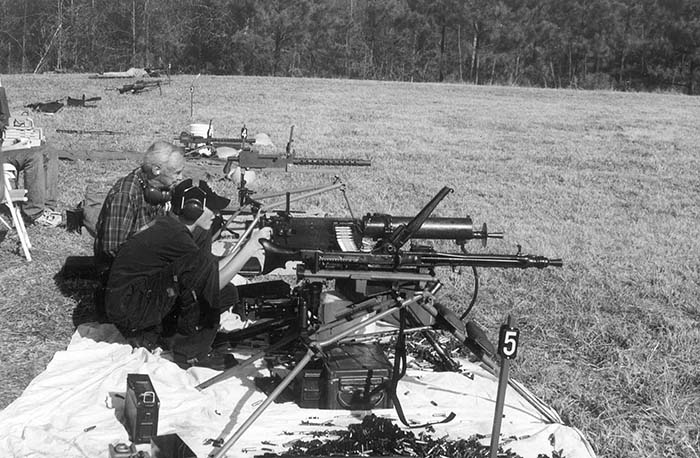Ed Anthony and his grandson, Miles Harris, firing the authors MG08 at the Red Hills Shoot. This was Miles first opportunity to fire full automatic firearms with his grandfather. Photo: Richard Hill
Born December 26, 1926
Died March 24, 2003
Inventor, Collector, Hero, Entrepreneur, Historian, Friend
How do we describe genius? How do we measure courage? William Edward “Ed” Anthony’s life has defined those standards. Ed’s long battle with cancer is over. However, this final battle was only one of many that would have embittered and destroyed a lesser man. Many of us have known him as this era’s greatest single source of military firearms history and technical knowledge. His collections are legend. But the man was so much more than his knowledge and accomplishments.
William Edward Anthony was a native of Gastonia, North Carolina where his family’s history predates the Civil War. In conversations with Ed, he told us much about his early life. He always represented himself as a “private and modest man” who loved his country, but who might not trust his government. He is a classic Southern Entrepreneur who made the most out of what opportunities were available to him.
He served as a Navy Corpsman in World War II and was practicing beach landings with the Marine Corps at Camp LeJeune, N.C. in 1944 when he became ill with a Strep A infection. It is ironic that, while Ed was fighting for his life from what we now know as “Toxic Shock,” his fellow Marines were fighting and dying in the South Pacific. His fight took him to the Norfolk Naval Hospital, Walter Reed Army Hospital, and finally to the Dublin Georgia Veterans Hospital where he had to learn to walk and talk again because of the effects of his illness. Discharged in 1946, Ed chose the University of North Carolina at Chapel Hill for his degree in chemistry and physics. A week after graduation, his father was gravely injured in a farm accident. Ed nursed him for eight months until his death. This tragic event kept Ed Anthony in Gastonia, instead of going to work for a large corporation.

Ed’s extraordinary business career included building a few “Dairy Queens on I-85,” a large machine shop operation servicing the textile industry, an auto parts and oil filter distributorship, his farm, a golf course, and his firearms and ordnance related activities. He held many patents for textile machinery and ordnance. Business success gave him the opportunity to indulge his love of firearms. He served as a Gastonia City Commissioner for twelve years, and considered his election six times without campaigning or spending a dime to be a major personal accomplishment.
Once during a visit, Ed showed me his pictures of firing tank cannon at Ft. Bragg. He said, “They called me and asked if I wanted to shoot some excess cannon shells. They asked if I would mind shooting from two different tanks because of excess barrel wear.” The reason for this invitation became clear during another visit when Ed showed us his patent for standoff defense against shaped charge anti-tank projectiles. He resented the US military’s unwillingness to use this technology to defend our troops in light tanks, APC’s and river craft against the RPG early in the Viet Nam fighting. His eventual patent for reactive armor was vindicated by the Israeli military success during the 1967 Six Day War and has become the universal standard for armored fighting vehicles.
I never knew Ed Anthony in his prime. He had beaten prostrate cancer and suffered from Parkinsons when we were introduced. Perhaps the fact that I had known Dr. Helmut Walther, the World War II German scientist who developed the panzerschreck and the panzerfaust anti-tank weapons interested him. Perhaps he appreciated someone who listened and soaked up the amazing information he presented. Whatever the reason, there was a bond that developed for which I will be forever grateful. He listened intently to what others said and used his brilliant analytical mind to challenge his own body of knowledge against what he heard. Kent Lomont said that once at Knob Creek, Ed was standing with a group of “cannon guys” listening to their descriptions of World War I artillery. After a while, Ed Anthony began describing obscure improvements that differentiated the models. His knowledge of all areas of ordnance was unique.

I purchased my PPSh41 from Ed Anthony. During that visit, he showed me the 2,000-rpm Soviet ShKas 1939 flexible aircraft gun pictured in Col. Chinn’s book (Re: Col. George M. Chinn, THE MACHINE GUN, Vol. II, Part VII, Chapter 4, PP. 72-82). Recently, Bob Landies related that after selling the gun to Ed, he received a call from him because the feed arm that controlled the rotary loading mechanism was missing. Bob offered to obtain a part to copy from the British MOD Pattern Room, but Ed wouldn’t hear of it. He had designed and machined a new linkage without any pattern. This is a simple example of his engineering mastery, mental discipline, and intense inner drive to be creative in spite of the Parkinsons. I and another friend purchased a large North Carolina machinegun collection in 1999 and took the 25 pieces by Gastonia to show him. His joy in handling each firearm was priceless and he described unique features of each gun. Ed Anthony never forgot anything mechanical.
Ed Anthony was a respected firearms engineering consultant. During the 1950’s, he represented U.S. Army Ordnance at Ft. Bragg and traveled extensively overseas to study ordnance technology and to find parts for foreign weapons. One of his later assignments took him to Morocco to deal with a problem involving a shaped charge anti-tank rocket propelled grenade. The weapon, designed by German and European engineers, had blinded several personnel because of the intense back blast in spite of blast shields. The problem was described as “Chuuff.” Ed studied the rockets and immediately diagnosed the initiating charge as the culprit. The designers had improperly used a high intensity rocket fuel for the initiating charge. With the correct initiating charge, over 5000 of the rockets were tested with no other injuries. Ed Anthony integrated his chemistry, physics, engineering and experience into every project or challenge he encountered

In November of 2001, Ed, his grandson Miles Harris and his old friend Richard Hill who collaborated with Ed to write their classic book “Confederate Longarms and Pistols,” were able to attend the Red Hills Machinegun Shoot near Toccoa, GA. The weather was clear and warm and the beltfeds were roaring. Ed and Miles shot the MG42 and MG08 and you could see the joy and pride of a grandfather being able to share this experience with his grandson. Maxwell G. “Max” Atchisson was shooting his patented M1 Thompson .22LR conversion. They shared the pleasure of two remarkable inventors examining and firing Max’s work. Ed did not have a Sterling SMG in his collection, and we offered him the chance to fire The David Co. MK VI from the Stembridge collection. He, Miles and Richard gave the Sterling a good workout. His response was, “Boy, That is just so smooth”. Two months later the recurrence of the cancer ended the chance for them to repeat this experience.
Ed Anthony knew Marshall “Carbine” Williams well and owned several of his personal firearms. Ed displayed a unique affection for the Browning 1917A1 .22LR conversion Williams developed for the U.S. Army and owned two of the original three prototypes and several of the 1,300 to 1,500 U.S military built sub-caliber Browning’s. Kent Lomont examined one of these models at the 1999 SHOT SHOW. Kent called Ed and the 1917A1 .22 found a new home. On our next visit, Ed was happy as a kid with a new toy, when he demonstrated his newly designed extractor cam that allowed this military production gun to function correctly. Marsh Williams told Ed that Gen. Julian Hatcher asked him to design a .22LR 1917A1 after the U.S. Army Ordnance Department’s complete failure to make a satisfactory model. Hatcher sent Williams a gun to use and his first attempt created so much energy that the Browning was destroyed. The inventor of the short stroke piston and auxiliary chamber apologized to General Hatcher. The General enthusiastically encouraged Williams to continue his work and immediately sent him several more guns.
I last talked to Ed on December 26, 2002. It was his birthday. He talked about converting Type 96 and 99 Japanese LMG’s to 7.62x39mm. I discussed a new early 1917 DWM MG08 Maxim in my collection. He talked about his pain. He talked about his family. He was sharp. I thanked him for teaching us so very much. He said, “I just wish I could teach you more. I love you.” I told him that I loved him too. What else can you say to a friend like Ed Anthony!
| This article first appeared in Small Arms Review V7N2 (November 2003) |











